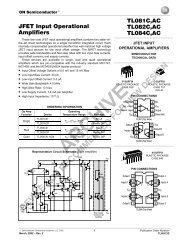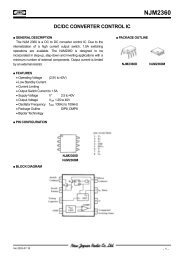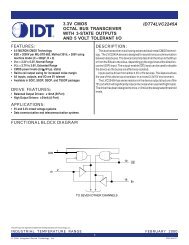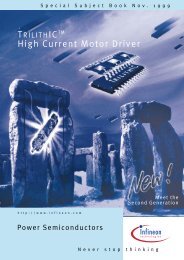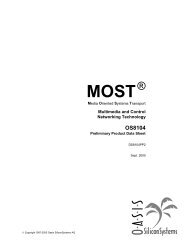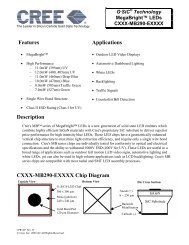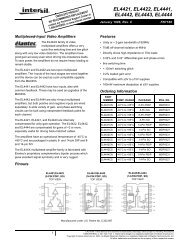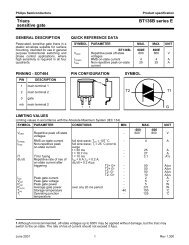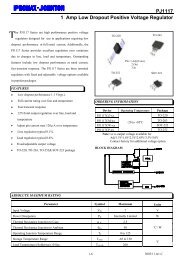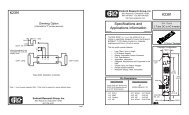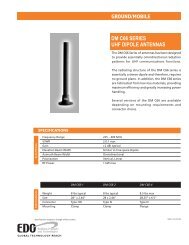AM/FM radio receiver circuit
AM/FM radio receiver circuit
AM/FM radio receiver circuit
You also want an ePaper? Increase the reach of your titles
YUMPU automatically turns print PDFs into web optimized ePapers that Google loves.
INTEGRATED CIRCUITS<br />
DATA SHEET<br />
TEA5591A<br />
<strong>AM</strong>/<strong>FM</strong> <strong>radio</strong> <strong>receiver</strong> <strong>circuit</strong><br />
Product specification<br />
File under Integrated Circuits, IC01<br />
February 1990
Philips Semiconductors<br />
Product specification<br />
<strong>AM</strong>/<strong>FM</strong> <strong>radio</strong> <strong>receiver</strong> <strong>circuit</strong><br />
TEA5591A<br />
GENERAL DESCRIPTION<br />
The TEA5591A is a 24-pin integrated <strong>radio</strong> <strong>circuit</strong>, derived from the TEA5591 and is designed for use in <strong>AM</strong>/<strong>FM</strong> portable<br />
<strong>radio</strong>s and clock <strong>radio</strong>s. The TEA5591A differs from the TEA5591 in that it has:<br />
• Separate IF input pins for <strong>AM</strong> and <strong>FM</strong><br />
• A split-up <strong>AM</strong>-IF stage (for distributed selectivity)<br />
• An LED driver indicator<br />
The main advantage of the TEA5591A is its ability to operate over a wide range of supply voltages (1.8 to 15 V) without<br />
any loss of performance.<br />
The <strong>AM</strong> <strong>circuit</strong> incorporates:<br />
• A double balance mixer<br />
• A ‘one-pin’ oscillator with amplitude control operating in the 0.6 to 30 MHz frequency range<br />
• A split-up IF amplifier<br />
• A detector<br />
• An AGC <strong>circuit</strong> which controls the IF amplifier and mixer.<br />
The <strong>FM</strong> <strong>circuit</strong> incorporates:<br />
• An RF input amplifier<br />
• A double balanced mixer<br />
• A ‘one-pin’ oscillator<br />
• Two IF amplifiers (for distributed selectivity)<br />
• A quadrature demodulator for a ceramic filter<br />
• Internal AFC<br />
Features<br />
• LED <strong>AM</strong>/<strong>FM</strong> indicator<br />
• A DC <strong>AM</strong>/<strong>FM</strong> switch facility<br />
• Three separate stabilizers to enable operation over a wide range of supply voltages (1.8 to 15 V)<br />
• All pins (except pin 10) are ESD protected<br />
PACKAGE OUTLINE<br />
24-lead shrink DIL; plastic (SOT234); SOT234-1; 1996 September 9.<br />
February 1990 2
Philips Semiconductors<br />
Product specification<br />
<strong>AM</strong>/<strong>FM</strong> <strong>radio</strong> <strong>receiver</strong> <strong>circuit</strong><br />
TEA5591A<br />
QUICK REFERENCE DATA<br />
PAR<strong>AM</strong>ETER CONDITIONS SYMBOL MIN. TYP. MAX. UNIT<br />
Supply voltage (pin 8) V P 1.8 − 15 V<br />
Total current consumption<br />
<strong>AM</strong> part I P − 14 − mA<br />
<strong>FM</strong> part I P − 17 − mA<br />
Operating ambient<br />
temperature range T amb −15 − + 60 °C<br />
<strong>AM</strong> performance (pin 1) note 1<br />
Sensitivity V o = 10 mV V i − 3.5 − µV<br />
(S + N)/N = 26 dB V i − 17 − µV<br />
Signal-to-noise ratio V i = 1 mV (S + N)/N − 48 − dB<br />
AF output voltage V o − 45 − mV<br />
Total harmonic distortion THD − 0.7 − %<br />
Signal handling m = 80%; THD = 8% V i − 100 − mV<br />
<strong>FM</strong> performance (pin 2) note 2<br />
Limiting sensitivity −3 dB V i − 2.3 − µV<br />
Signal-to-noise ratio V i = 2.5 µV (S + N)/N − 26 − dB<br />
V i = 1 mv (S + N)/N − 60 − dB<br />
AF output voltage V o − 90 − mV<br />
Total harmonic distortion THD − 0.8 − %<br />
Signal handling V i − 100 − mV<br />
<strong>AM</strong> suppression 100 µV < V i <<br />
100 mV <strong>AM</strong>S − 40 − dB<br />
Notes to the quick reference data<br />
1. All parameters are measured in the application <strong>circuit</strong> (see Fig.4) at nominal supply voltage V p = 3 V; T amb = 25 °C;<br />
unless otherwise specified. RF conditions: Input frequency 1 MHz; 30% modulated with f mod = 1 kHz; unless<br />
otherwise specified.<br />
2. All parameters are measured in the application <strong>circuit</strong> (see Fig.4) at nominal supply voltage V P = 3 V; T amb = 25 °C;<br />
unless otherwise specified. RF conditions: Input frequency 100 MHz; frequency deviation ∆f = 22.5 kHz and f mod = 1<br />
kHz; unless otherwise specified.<br />
February 1990 3
This text is here in white to force landscape pages to be rotated correctly when browsing through the pdf in the Acrobat reader.This text is here in<br />
_white to force landscape pages to be rotated correctly when browsing through the pdf in the Acrobat reader.This text is here inThis text is here in<br />
white to force landscape pages to be rotated correctly when browsing through the pdf in the Acrobat reader. white to force landscape pages to be ...<br />
February 1990 4<br />
Fig.1 Block diagram.<br />
<strong>AM</strong>/<strong>FM</strong> <strong>radio</strong> <strong>receiver</strong> <strong>circuit</strong> TEA5591A<br />
Philips Semiconductors Product specification
This text is here in white to force landscape pages to be rotated correctly when browsing through the pdf in the Acrobat reader.This text is here in<br />
_white to force landscape pages to be rotated correctly when browsing through the pdf in the Acrobat reader.This text is here inThis text is here in<br />
white to force landscape pages to be rotated correctly when browsing through the pdf in the Acrobat reader. white to force landscape pages to be ...<br />
February 1990 5<br />
Fig.2 Equivalent <strong>circuit</strong> diagram.<br />
<strong>AM</strong>/<strong>FM</strong> <strong>radio</strong> <strong>receiver</strong> <strong>circuit</strong> TEA5591A<br />
Philips Semiconductors Product specification
Philips Semiconductors<br />
Product specification<br />
<strong>AM</strong>/<strong>FM</strong> <strong>radio</strong> <strong>receiver</strong> <strong>circuit</strong><br />
TEA5591A<br />
PINNING<br />
Fig.3 Pinning diagram.<br />
February 1990 6
Philips Semiconductors<br />
Product specification<br />
<strong>AM</strong>/<strong>FM</strong> <strong>radio</strong> <strong>receiver</strong> <strong>circuit</strong><br />
TEA5591A<br />
RATINGS<br />
Limiting values in accordance with the Absolute Maximum System (IEC 134)<br />
PAR<strong>AM</strong>ETER SYMBOL MIN. MAX. UNIT<br />
Supply voltage (pin 8) V P − 18 V<br />
LED current (pin 7) I 7 − tbf mA<br />
Total power dissipation P tot see Fig.4<br />
Storage temperature range T stg −65 +150 °C<br />
Operating ambient temperature range T amb −15 +60 °C<br />
Electrostatic handling (1) V es −1000 +1000 V<br />
Note<br />
1. Equivalent to discharging a 100 pF capacitor through a 1500 Ω series resistor.<br />
Fig.4 Power derating curve.<br />
February 1990 7
Philips Semiconductors<br />
Product specification<br />
<strong>AM</strong>/<strong>FM</strong> <strong>radio</strong> <strong>receiver</strong> <strong>circuit</strong><br />
TEA5591A<br />
DC CHARACTERISTICS<br />
All voltages are referenced to pin 3 and pin 9; all input currents are positive; all parameters are measured in test set-up<br />
(see Fig.6) at nominal supply voltage V P = 3 V; T amb = 25 °C unless otherwise specified<br />
PAR<strong>AM</strong>ETER CONDITIONS SYMBOL MIN. TYP. MAX. UNIT<br />
Supply voltage V P 1.8 3.0 15 V<br />
Voltages (<strong>FM</strong>)<br />
pin 2 V 2 − 0.90 − V<br />
pin 4 V 4 − 0.85 − V<br />
pin 5 V 5 − 1.60 − V<br />
pin 6 V 6 − 1.48 − V<br />
pin 10 V 10 − 1.05 − V<br />
pin 18 V 18 − 1.60 − V<br />
pin 19 V 19 − 1.58 − V<br />
pin 21 V 21 − 0.69 − V<br />
pin 23 V 23 − 1.60 − V<br />
Voltages (<strong>AM</strong>)<br />
pin 14 V 14 − 1.60 − V<br />
pin 16 V 16 − 1.54 − V<br />
pin 19 V 19 − 1.10 − V<br />
Total current consumption note 1<br />
<strong>AM</strong> part I P − 14 19 mA<br />
<strong>FM</strong> part I P − 17 23 mA<br />
Note to the DC characteristics<br />
1. Without LED current.<br />
February 1990 8
Philips Semiconductors<br />
Product specification<br />
<strong>AM</strong>/<strong>FM</strong> <strong>radio</strong> <strong>receiver</strong> <strong>circuit</strong><br />
TEA5591A<br />
AC CHARACTERISTICS<br />
All parameters are measured in test set-up (see Fig.6) at nominal supply voltage V P = 3 V; T amb = 25 °C unless<br />
otherwise specified<br />
<strong>AM</strong> part<br />
PAR<strong>AM</strong>ETER CONDITIONS SYMBOL MIN. TYP. MAX. UNIT<br />
<strong>AM</strong> front end<br />
(pin 1 to 17) note 1<br />
Conversion<br />
transconductance V i = 10 mV<br />
V AGC (pin 16) = V 14 − 0.1 V S C 9.3 12 13.5 mA/V<br />
V i = 10 mV<br />
V AGC (pin 16) = V 14 − 0.45 V S C 0.75 1.1 1.3 mA/V<br />
IF suppression note 2<br />
V i = 10 mV α 20 26 − dB<br />
Oscillator (pin 13)<br />
Voltage f = 1.5 MHz V osc 110 175 200 mV<br />
f = 1.5 MHz<br />
V P = 1.5 V V osc 60 160 − mV<br />
IF and detector part<br />
(pin 15 to 11) note 3<br />
IF sensitivity;<br />
AF output voltage no AGC; V i = 45 µV V o 12 20 55 mV<br />
Signal + noise to noise<br />
ratio for an IF input no AGC; V i = 45 µV S + N/N 23 25 − dB<br />
AF output voltage V i = 1 mV V o 35 45 60 mV<br />
Total harmonic<br />
V i = 10 mV<br />
distortion m = 80% THD − 1 2.2 %<br />
LED-indicator <strong>circuit</strong><br />
(pin 7)<br />
Output current V i = 0 V l ind − (8) (8) µA<br />
V i = 1 mV l ind<br />
(8) (8)<br />
− mA<br />
Overall performance<br />
(pin 1 to 11) note 4<br />
Total harmonic<br />
distortion V i = (8) mV THD − 4.5 8 %<br />
<strong>FM</strong> part<br />
<strong>FM</strong> frond end<br />
(pin 2 to 20) note 5<br />
Conversion<br />
transconductance V i = 1 mV S C 7.5 11 13.5 mA/V<br />
February 1990 9
Philips Semiconductors<br />
Product specification<br />
<strong>AM</strong>/<strong>FM</strong> <strong>radio</strong> <strong>receiver</strong> <strong>circuit</strong><br />
TEA5591A<br />
PAR<strong>AM</strong>ETER CONDITIONS SYMBOL MIN. TYP. MAX. UNIT<br />
Oscillator (pin 22)<br />
Voltage V AFC (pin 21)<br />
= 0.8 V V osc 155 200 245 mV<br />
V AFC = 0.8 V<br />
V P = 1.5 V V osc 60 120 − mV<br />
AFC control; change in<br />
oscillator frequency V AFC = 0.8 V f − 111.2 − MHz<br />
∆V AFC = −0.6 V ∆f − +420 − kHz<br />
∆V AFC = +0.6 V ∆f − −620 − kHz<br />
IF and demodulator part<br />
(pin 18 to 11) note 6<br />
IF sensitivity; note 7<br />
AF output voltage V i = 100 µV V o −3 −1 0 dB<br />
Signal + noise to noise<br />
ratio for an IF input V i = 100 µV;<br />
out of limiting S + N/N 26 30 − dB<br />
AF output voltage V i = 1 mV V o 75 90 120 mV<br />
Total harmonic<br />
∆f = 75 kHz<br />
distortion V i = 50 mV THD − 3 − %<br />
LED-indicator <strong>circuit</strong><br />
(pin 7)<br />
Output current V i = 0 V l ind − − 20 µA<br />
V i = 1 mV l ind 0.6 1 1.9 mA<br />
Notes to the AC characteristics<br />
1. Input frequency = 1 MHz; output frequency = 468 kHz.<br />
2. α =<br />
( V o<br />
at f i<br />
= 1MHz )<br />
---------------------------------------------------------- .<br />
( V o<br />
at f i<br />
= 468kHz )<br />
3. Input frequency = 468 kHz; m = 30% modulated with f mod = 1 kHz; unless otherwise specified.<br />
4. Front-end connected to IF plus detector part. Input frequency = 1 MHz; m = 80% modulated with<br />
f mod = 1 kHz.<br />
5. Input frequency = 100 MHz; output frequency = 10.7 MHz.<br />
6. Input frequency = 10.7 MHz; frequency deviation, ∆f = 22.5 kHz and f mod = 1 kHz; unless<br />
otherwise specified.<br />
7. Reference: AF output voltage = 0 dB at V i = 1 mV.<br />
8. Value to be fixed.<br />
February 1990 10
This text is here in white to force landscape pages to be rotated correctly when browsing through the pdf in the Acrobat reader.This text is here in<br />
_white to force landscape pages to be rotated correctly when browsing through the pdf in the Acrobat reader.This text is here inThis text is here in<br />
white to force landscape pages to be rotated correctly when browsing through the pdf in the Acrobat reader. white to force landscape pages to be ...<br />
February 1990 11<br />
Fig.5 Application <strong>circuit</strong>.<br />
APPLICATION AND TEST INFORMATION<br />
<strong>AM</strong>/<strong>FM</strong> <strong>radio</strong> <strong>receiver</strong> <strong>circuit</strong> TEA5591A<br />
Philips Semiconductors Product specification
This text is here in white to force landscape pages to be rotated correctly when browsing through the pdf in the Acrobat reader.This text is here in<br />
_white to force landscape pages to be rotated correctly when browsing through the pdf in the Acrobat reader.This text is here inThis text is here in<br />
white to force landscape pages to be rotated correctly when browsing through the pdf in the Acrobat reader. white to force landscape pages to be ...<br />
February 1990 12<br />
(1) MP = measurement pin.<br />
(2) VS = voltage source.<br />
Fig.6 Test <strong>circuit</strong>.<br />
<strong>AM</strong>/<strong>FM</strong> <strong>radio</strong> <strong>receiver</strong> <strong>circuit</strong> TEA5591A<br />
Philips Semiconductors Product specification
Philips Semiconductors<br />
Product specification<br />
<strong>AM</strong>/<strong>FM</strong> <strong>radio</strong> <strong>receiver</strong> <strong>circuit</strong><br />
TEA5591A<br />
PACKAGE OUTLINE<br />
SDIP24: plastic shrink dual in-line package; 24 leads (400 mil)<br />
SOT234-1<br />
D<br />
M E<br />
seating plane<br />
A 2<br />
A<br />
L<br />
A 1<br />
w M<br />
Z<br />
e<br />
b 1<br />
c<br />
(e ) 1<br />
24<br />
b<br />
13<br />
M H<br />
pin 1 index<br />
E<br />
1<br />
12<br />
0 5 10 mm<br />
scale<br />
DIMENSIONS (mm are the original dimensions)<br />
A A 1 A 2<br />
(1) (1)<br />
UNIT max. min. max. b b 1 c D E e e 1 L M E M H<br />
mm<br />
4.7 0.51 3.8<br />
1.3<br />
0.8<br />
0.53<br />
0.40<br />
0.32<br />
0.23<br />
22.3<br />
21.4<br />
9.1<br />
8.7<br />
1.778 10.16<br />
3.2<br />
2.8<br />
10.7<br />
10.2<br />
12.2<br />
10.5<br />
w<br />
0.18<br />
(1)<br />
Z<br />
max.<br />
1.6<br />
Note<br />
1. Plastic or metal protrusions of 0.25 mm maximum per side are not included.<br />
OUTLINE<br />
VERSION<br />
REFERENCES<br />
IEC JEDEC EIAJ<br />
EUROPEAN<br />
PROJECTION<br />
ISSUE DATE<br />
SOT234-1<br />
92-11-17<br />
95-02-04<br />
February 1990 13
Philips Semiconductors<br />
Product specification<br />
<strong>AM</strong>/<strong>FM</strong> <strong>radio</strong> <strong>receiver</strong> <strong>circuit</strong><br />
TEA5591A<br />
SOLDERING<br />
Introduction<br />
There is no soldering method that is ideal for all IC packages. Wave soldering is often preferred when through-hole and<br />
surface mounted components are mixed on one printed-<strong>circuit</strong> board. However, wave soldering is not always suitable for<br />
surface mounted ICs, or for printed-<strong>circuit</strong>s with high population densities. In these situations reflow soldering is often<br />
used.<br />
This text gives a very brief insight to a complex technology. A more in-depth account of soldering ICs can be found in our<br />
“IC Package Databook” (order code 9398 652 90011).<br />
Soldering by dipping or by wave<br />
The maximum permissible temperature of the solder is 260 °C; solder at this temperature must not be in contact with the<br />
joint for more than 5 seconds. The total contact time of successive solder waves must not exceed 5 seconds.<br />
The device may be mounted up to the seating plane, but the temperature of the plastic body must not exceed the<br />
specified maximum storage temperature (T stg max ). If the printed-<strong>circuit</strong> board has been pre-heated, forced cooling may<br />
be necessary immediately after soldering to keep the temperature within the permissible limit.<br />
Repairing soldered joints<br />
Apply a low voltage soldering iron (less than 24 V) to the lead(s) of the package, below the seating plane or not more<br />
than 2 mm above it. If the temperature of the soldering iron bit is less than 300 °C it may remain in contact for up to<br />
10 seconds. If the bit temperature is between 300 and 400 °C, contact may be up to 5 seconds.<br />
DEFINITIONS<br />
Data sheet status<br />
Objective specification This data sheet contains target or goal specifications for product development.<br />
Preliminary specification This data sheet contains preliminary data; supplementary data may be published later.<br />
Product specification This data sheet contains final product specifications.<br />
Limiting values<br />
Limiting values given are in accordance with the Absolute Maximum Rating System (IEC 134). Stress above one or<br />
more of the limiting values may cause permanent damage to the device. These are stress ratings only and operation<br />
of the device at these or at any other conditions above those given in the Characteristics sections of the specification<br />
is not implied. Exposure to limiting values for extended periods may affect device reliability.<br />
Application information<br />
Where application information is given, it is advisory and does not form part of the specification.<br />
LIFE SUPPORT APPLICATIONS<br />
These products are not designed for use in life support appliances, devices, or systems where malfunction of these<br />
products can reasonably be expected to result in personal injury. Philips customers using or selling these products for<br />
use in such applications do so at their own risk and agree to fully indemnify Philips for any damages resulting from such<br />
improper use or sale.<br />
February 1990 14



